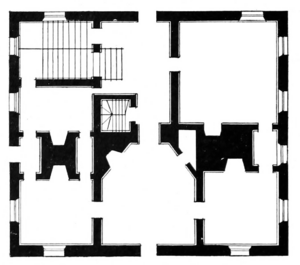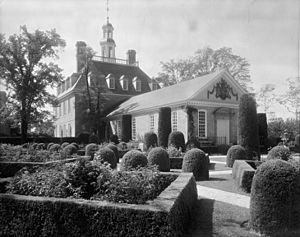Governor's Palace (Williamsburg, Virginia) facts for kids
Quick facts for kids Governor's Palace |
|
|---|---|
 |
|
| General information | |
| Architectural style | English Baroque (original) Colonial Revival (Reconstruction) |
| Location | Williamsburg, Virginia |
| Country | United States of America |
| Construction started | 1706 (original) 1931 (reconstruction) |
| Destroyed | December 22, 1781 |
| Owner | Colonial Williamsburg |
|
Governor's Palace
|
|
|
U.S. National Historic Landmark District
Contributing Property |
|
| Location | Williamsburg, Virginia |
| Built | 1931-34 |
| Part of | Williamsburg Historic District (ID66000925) |
| Added to NRHP | October 15, 1966 |
The Governor's Palace in Williamsburg, Virginia, was once the official home for the royal governors of the Colony of Virginia. These governors were like the leaders of the colony when it was still under British rule. After the American Revolution, two important governors, Patrick Henry and Thomas Jefferson, also lived here. The capital of Virginia moved to Richmond in 1780, and so did the governor's home. Sadly, the main palace building burned down in 1781. However, the smaller buildings around it lasted a bit longer. In the 1930s, the Governor's Palace was rebuilt exactly where it used to stand. Today, it's one of the biggest buildings you can see at Colonial Williamsburg, along with the Capitol.
Contents
History of the Governor's Palace
Williamsburg became the new capital city of the Virginia colony in 1699. It served as the capital until 1780. For most of that time, the Governor's Palace was the official home for the royal governor.
Building the Palace
The idea for the palace came from Lt. Governor Edward Nott in 1706. The House of Burgesses, which was like the colony's government, provided the money. Construction began in 1706.
The first official resident was Lt. Governor Alexander Spotswood in 1710. He acted as governor because the main governor, George Hamilton, 1st Earl of Orkney, never actually visited Virginia. Spotswood continued to improve the palace until about 1722. He added the front courtyard, beautiful gardens, and many decorations.
Later, from 1751 to 1752, Lt. Gov. Robert Dinwiddie had the palace repaired and updated. During this time, a large addition was built at the back, which included a grand ballroom.
Who Lived There?
Seven royal governors lived in the original palace:
- Alexander Spotswood
- Francis Fauquier
- Lord Botetourt
- Hugh Drysdale
- William Gooch
- Robert Dinwiddie
- John Murray, 4th Earl of Dunmore
One colonial mayor also lived there:
- John Amson, from 1750 to 1751
After the American Revolution, two important governors of Virginia lived in the palace:
- Patrick Henry, from 1776 to 1779
- Thomas Jefferson, from 1779 to 1780
The Palace is Destroyed
Around 1779, Governor Thomas Jefferson wanted to redesign the palace. He planned to add temple-like porches to the front and back. These designs were in his favorite neoclassical style.
However, in 1780, Jefferson suggested moving Virginia's capital to Richmond. This was for safety during the American Revolution. The new home for the governor in Richmond was smaller and simpler. It is now called the Governor's Mansion.
On December 22, 1781, the main palace building was destroyed by a fire. At that time, it was being used as a hospital for American soldiers wounded during the nearby Siege of Yorktown. Some brick outbuildings survived the fire. But they were later taken apart during the American Civil War. Their bricks were used for other buildings by soldiers.
Rebuilding the Governor's Palace
In the early 1900s, the Reverend Dr. W.A.R. Goodwin and philanthropist John D. Rockefeller Jr. worked together to rebuild the palace. Rockefeller's family provided a lot of the money needed for this big project.
The reconstruction was very careful. It was based on many clues from the past. Workers dug up the original foundations and cellar, finding old pieces of the building that had fallen during the fire. Jefferson's drawings for his planned renovation also helped show what the inside looked like.
In 1929, a special copper plate was found in England. It was called the Bodleian Plate. This plate showed pictures of the palace's outside from around 1740. It also showed the Capitol and the Wren Building. Other clues came from old records and original items. The rebuilt palace, its smaller buildings, and the gardens opened to visitors on April 23, 1934.
In 1981, the Governor's Palace was updated again. Its inside and furnishings were changed to match new discoveries about the building. This made it even more historically accurate.
See also
 In Spanish: Palacio del Gobernador (Virginia) para niños
In Spanish: Palacio del Gobernador (Virginia) para niños



